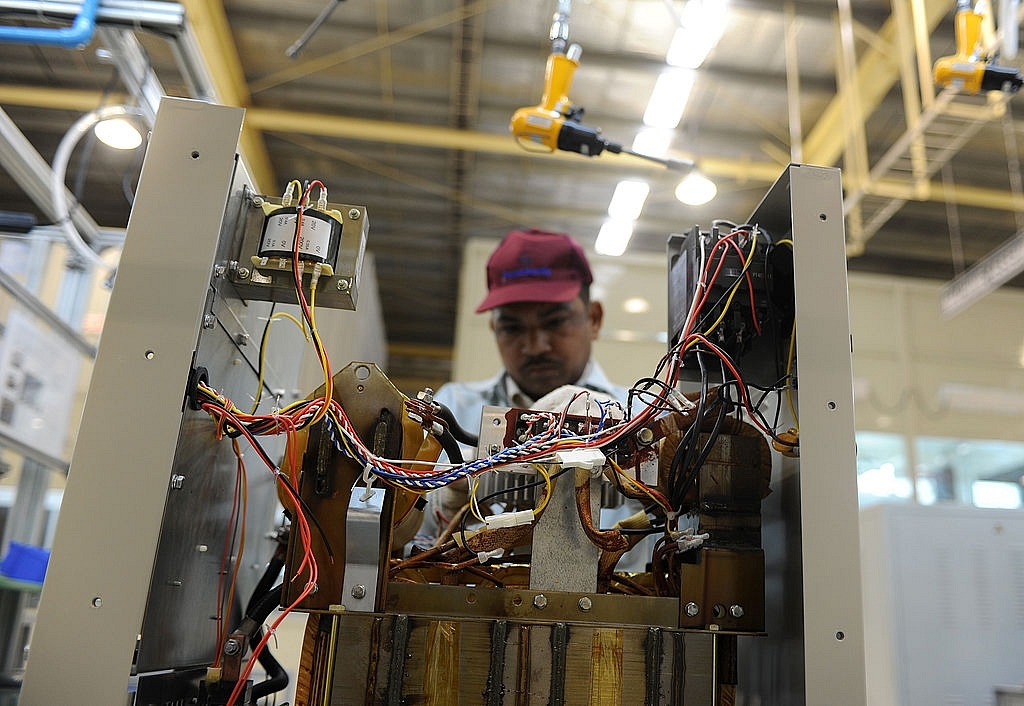Economy
The IIP Is A Disgrace: It Is On Some Other Planet, Not Grounded In Reality

An Indian employee works at the Panasonic ‘eco ideas’ factory at Jhajjar in Haryana.(Photo credit: SAJJAD HUSSAIN/AFP/Getty Images)
Will someone rid us of our meaningless Index of Industrial Production (IIP)? The index no longer serves any useful purpose, as it seems to signal nothing on which policies can be based.
Going by the IIP, Reserve Bank Governor Urjit Patel should be slashing interest rates regularly since the industry is in decline mode. But this scenario is impossible to confirm when one looks at anecdotal evidence from various industrial sectors.
The latest IIP, for August, tells us that industry de-grew again by 0.7 percent, after a negative growth of -2.5 percent in July. For the April-August period, the IIP reports -0.3 percent growth. In calendar 2016 (January-August), industry has reported negative growth in three of the eight months.
The April-August index tells us that manufacturing, which accounts for over 75 percent of the IIP, is dragging down the index, while mining and electricity are in positive territory, but their weights are 14 percent and 10 percent.
In terms of the use-based classification of goods (basic, intermediate, capital and consumption sectors), the drag is clearly in capital goods (-21.4 percent in April-August), which looks plausible, since the industry is deleveraging and there is enough capacity to handle any growth in demand. The industry is maximising existing capacity before investing. The investment cycle clearly is yet to turn.
But with just under 9 per cent weight in the IIP, the tail is wagging the dog. The capital goods sector seems to be single-handedly impacting the IIP’s growth. Clearly, the lumpiness of capital goods production is a problem area, but surely our statisticians can find a way to smoothen this number with better and more granular data collection? Thus while basic, intermediate and consumption goods show positive growth, the deep negative growth in capital goods is skewing the whole picture.
The reality is the economy is ticking positively even though investment is yet to pick up due to the death blow given to it in the UPA years, when the government cut capital expenditures and many big projects turned turtle, blotting the balance-sheets of both companies and banks.
On the other hand, consider the robust numbers coming from several sectors. According to a Business Standard report today (11 October), passenger vehicles and two-wheelers grew at 17.8 percent and 20 percent plus in the July-September quarter, and airlines reported 23 percent growth in passenger traffic in April-August.
Indirect tax collections, another important indicator of the health of the economy, were up 26 percent in the first half of this fiscal (April-September), with excise revenues rising 46 percent and service tax 22 percent. Only customs duty grew by an anaemic 4.8 percent, which is indicative of the weak global trade environment.
We know that the Seventh Pay Commission payouts started happening in August, and rural demand will revive after the Kharif crop is in later this year. We also know that government investments in infrastructure, especially roads and railways, will pick up as the year proceeds. One wonders what signal the IIP numbers dished out so far sends to policy-makers.
If fiscal and monetary policies have to be forward-looking rather than backward-looking, the IIP is a waste of time till it is completely rejigged with a new base year. Time to dump the old one ASAP.
The current IIP is a shame.
Support Swarajya's 50 Ground Reports Project & Sponsor A Story
Every general election Swarajya does a 50 ground reports project.
Aimed only at serious readers and those who appreciate the nuances of political undercurrents, the project provides a sense of India's electoral landscape. As you know, these reports are produced after considerable investment of travel, time and effort on the ground.
This time too we've kicked off the project in style and have covered over 30 constituencies already. If you're someone who appreciates such work and have enjoyed our coverage please consider sponsoring a ground report for just Rs 2999 to Rs 19,999 - it goes a long way in helping us produce more quality reportage.
You can also back this project by becoming a subscriber for as little as Rs 999 - so do click on this links and choose a plan that suits you and back us.
Click below to contribute.
Latest